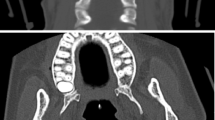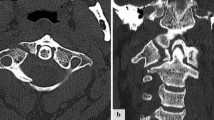Abstract
The authors report a very rare case of bilateral occipital condyle fractures (OCF) that was associated with complete separation fracture of the inferior clivus resulting in craniocervical dislocation alongside dissociation of C1–C2 joint complex. Also, a new type of the Anderson and Montesano classification system is presented with two subtypes of injuries. Type IVA occurs when the OCF is associated a clivus avulsion fracture, while Type IVB occurs when the OCF is associated with complete “en piece” separation fracture of the inferior clivus. Both Type IV injuries are considered highly unstable, and surgical fixation is the recommended treatment option.






Similar content being viewed by others
References
Alker GJ Jr, Oh YS, Leslie EV (1978) High cervical spine and craniocervical junction injuries in fatal traffic accidents: a radiological study. Orthop Clin North Am 9:1003–1010
Anderson PA, Montesano PX (1988) Morphology and treatment of occipital condyle fractures. Spine (Phila Pa 1976) 13:731–736
Aulino JM, Tutt LK, Kaye JJ, Smith PW, Morris JA Jr (2005) Occipital condyle fractures: clinical presentation and imaging findings in 76 patients. Emerg Radiol 11(6):342–347
Bell C (1817) Surgical observations. Middlesex Hosp J 4:469–470
Bohlman HH (1979) Acute fractures and dislocations of the cervical spine. An analysis of three hundred hospitalized patients and review of the literature. J Bone Joint Surg Am 61:1119–1142
Bucholz RW, Burkhead WZ (1979) The pathological anatomy of fatal atlantooccipital dislocations. J Bone Joint Surg Am 61:248–250
Caroli E, Rocchi G, Orlando ER, Delfini R (2005) Occipital condyle fractures: report of five cases and literature review. Eur Spine J 14:487–492
Dashti R, Onur Ulu M, Albayram S, Aydin S, Ulusoy L, Hanci M (2007) Concomitant fracture of bilateral occipital condyle and inferior clivus: what is the mechanism of injury? Eur Spine J 16(Suppl 3):S261–S264
Fuentes S, Bouillot P, Dufour H, Grisoli F (2000) Occipital condyle fractures and clivus epidural hematoma Case report. Neurochirurgie 46:563–567
Hanson JA, Deliganis AV, Baxter WA, Linnau KF, Wilson AJ, Mann FA (2002) Radiologic and clinical spectrum of occipital condyle fractures: retrospective review of 107 consecutive fractures in 95 patients. AJR 178:1261–1268
Imamura T, Kojima T, Yashiki M, Namera A (2000) Traumatic avulsion fracture of the occipital condyles and clivus: a case report. Leg Med (Tokyo) 2(1):49–53
Jones DN, Knox AM, Sage MR (1990) Traumatic avulsion fracture of the occipital condyles and clivus with associated unilateral atlantooccipital distraction. AJNR Am J Neuroradiol 11:1181–1183
Leone A, Cerase A, Colosimo C, Lauro L, Puca A, Marano P (2000) Occipital condylar fractures: a review. Radiology 216:635–644
Malham GM, Ackland HM, Rachel J, Williamson OD, Varma DK (2009) Occipital condyle fractures: incidence and clinical follow-up at a level 1 trauma centre. Emerg Radiol 16:291–297
Maserati MB, Stephens B, Zohny Z, Lee JY, Kanter AS, Spiro RM, Okonkwo DO (2009) Occipital condyle fractures: clinical decision rule and surgical management. J Neurosurg Spine 11:388–395
Maughan PH, Horn EM, Theodore N, Feiz-Erfan I, Sonntag VK (2005) Avulsion fracture of the foramen magnum treated with occiput-to-c1 fusion: technical case report. Neurosurgery 57(3):E600
Mueller FJ, Fuechtmeier B, Kinner B, Rosskopf M, Neumann C, Nerlich M et al (2012) Occipital condyle fractures. Prospective follow-up of 31 cases within 5 years at a level 1 trauma centre. Eur Spine J 21:289–294
Tanabe M, Watanabe T, Matsumoto S, Okamoto H, Shirakashi K (1999) Avulsion fracture of the anterior half of the foramen magnum involving the bilateral occipital condyles and the inferior clivus: Case report. Neurol Med Chir (Tokyo) 39:358–361
Theodore N, Aarabi B, Dhalll SS, Gelb DE, Hurlbert RJ, Rozzelle CJ, Ryken TC, Walters BC, Hadley MN (2013) Occipital condyle fracture. Neurosurgery 72:106–113
Tuli S, Tator CH, Fehlings MG, Mackay M (1997) Occipital condyle fractures. Neurosurgery 41:368–376
Author information
Authors and Affiliations
Corresponding author
Ethics declarations
The authors declare not having funding or any conflict of interest. The present study was done at the Spine Department of London Bridge Hospital. The patient involved in this study gave authorization and now lives in Qatar.
Additional information
Publisher's note
Springer Nature remains neutral with regard to jurisdictional claims in published maps and institutional affiliations.
Comments
The authors present an unusual fracture pattern of the occipital clivus area consisting of bilateral occipital condyle fractures and inferior clivus separation fracture, as well as C1-C2 dislocation. The patient was treated by halo and then, several days later, surgical fixation was carried out. Surprisingly, at two years, the patient had completely normal neurological examination. Present classifications do not describe this fracture subtype, and the authors propose a novel Type IV injury by dividing it to two types: Type IVA occurs when the occipital condyle fractures (OCF) is associated a clivus avulsion, and Type IVB when the OCF is associated with “en piece” fracture of the clivus. Certainly, this is an unusual fracture pattern, and I congratulate the authors on the excellent outcome.
Volker Sonntag
Phoenix, Arizona, USA
This article is part of the Topical Collection on Spine trauma
Rights and permissions
About this article
Cite this article
Lam, K.S., Carriço, G., Fernandes, F.M. et al. A rare case of bilateral occipital condyle fractures associated with inferior clivus separation fracture resulting in craniocervical dislocation: a case report and modification of the Anderson and Montesano classification is proposed. Acta Neurochir 163, 2307–2311 (2021). https://doi.org/10.1007/s00701-021-04855-7
Received:
Accepted:
Published:
Issue Date:
DOI: https://doi.org/10.1007/s00701-021-04855-7




